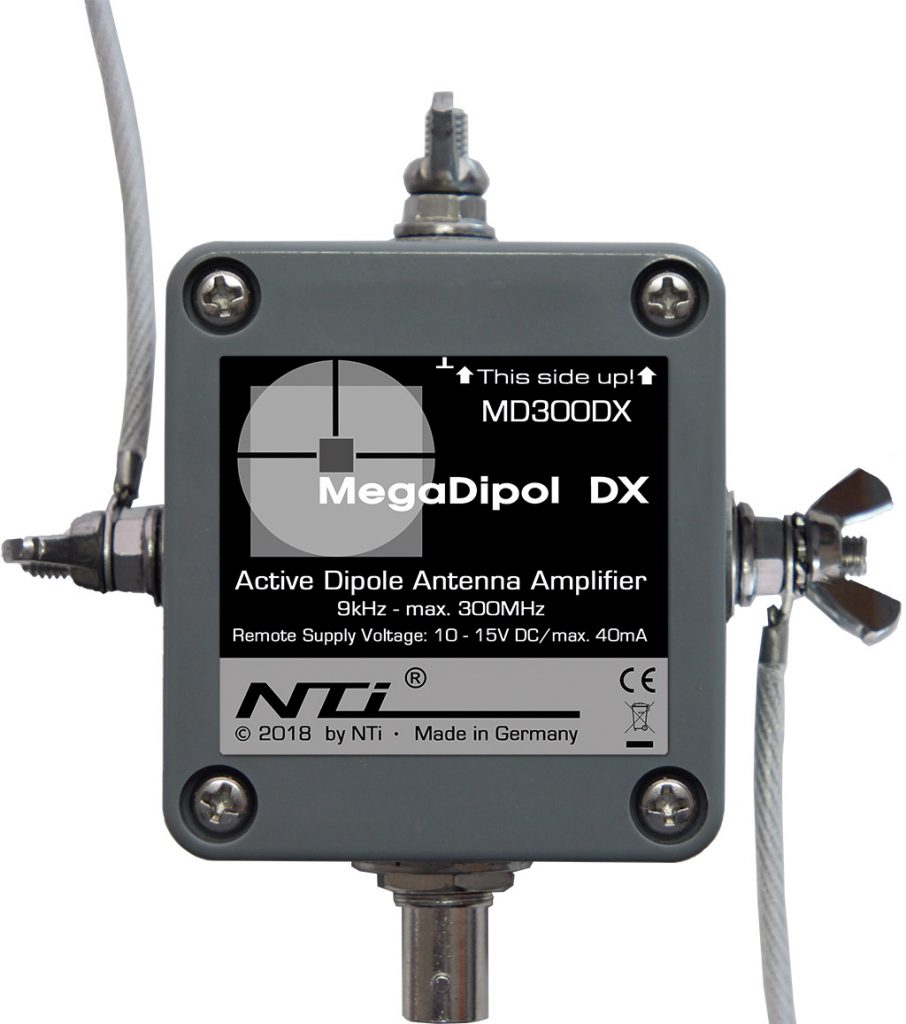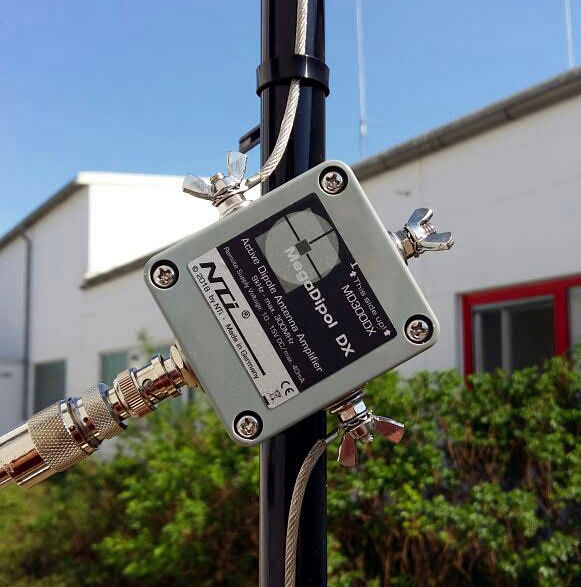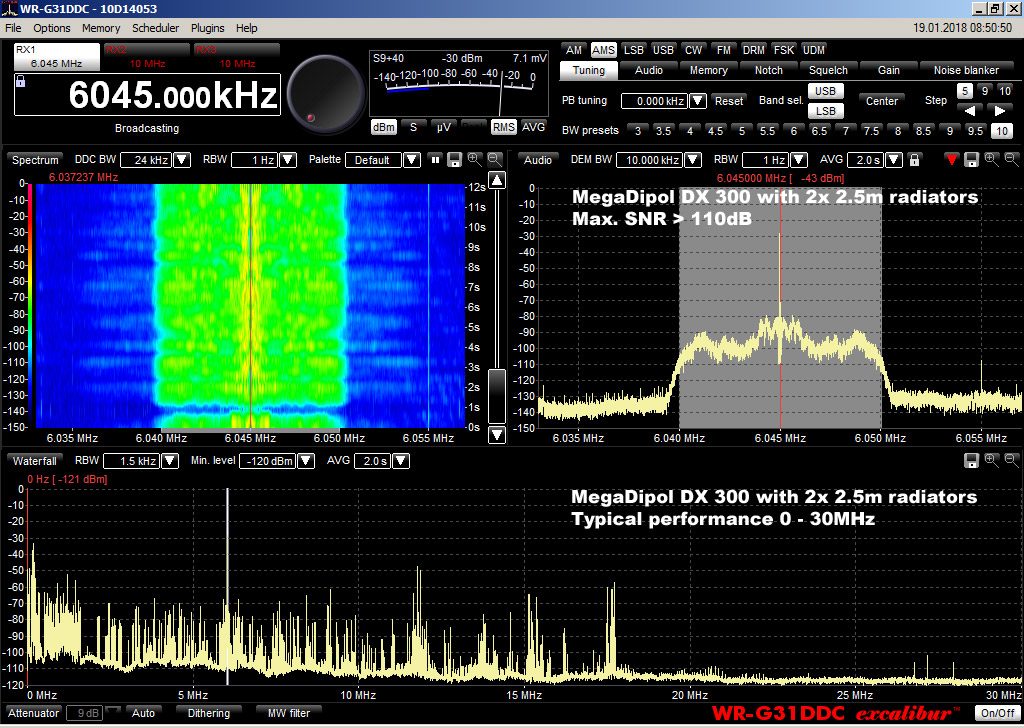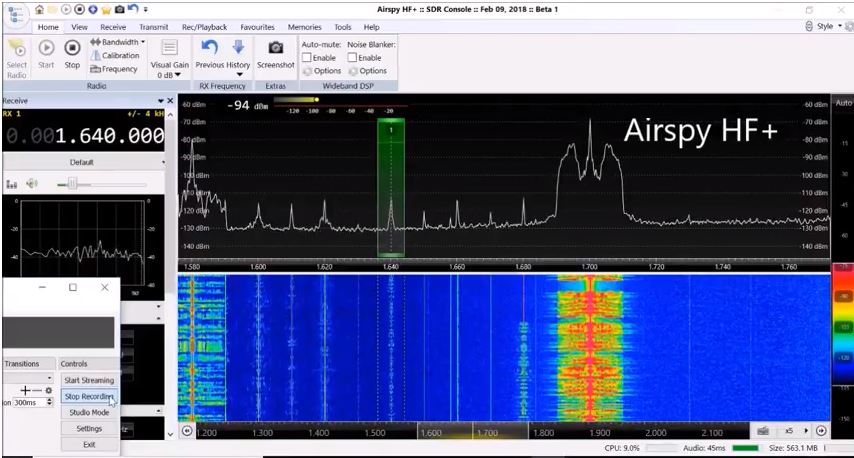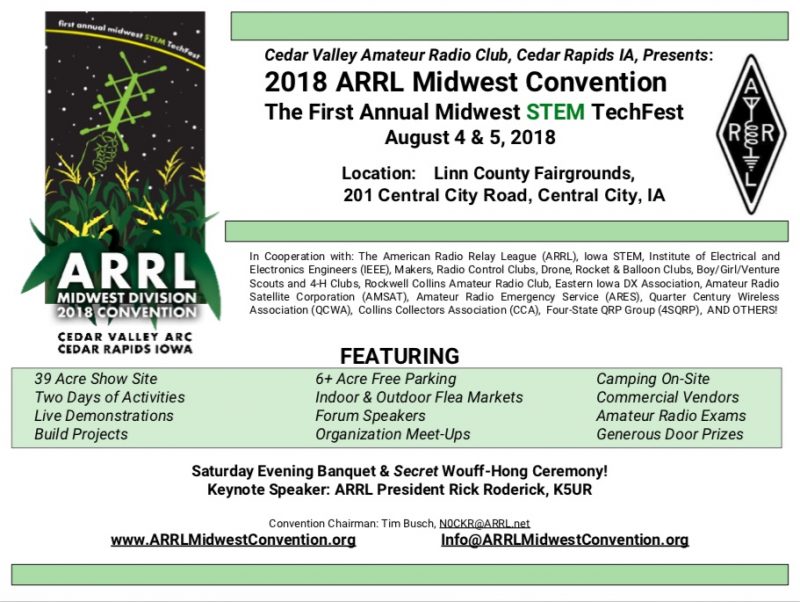 Many thanks to SWLing Post contributor, Dave Cripe (NM0S) for sharing the flyer above announcing the first annual Midwest STEM TechFest. This looks like an exciting event and frankly where I believe where most amateur radio conventions should be investing their time: in recruiting future engineers and makers! Well done!
Many thanks to SWLing Post contributor, Dave Cripe (NM0S) for sharing the flyer above announcing the first annual Midwest STEM TechFest. This looks like an exciting event and frankly where I believe where most amateur radio conventions should be investing their time: in recruiting future engineers and makers! Well done!
Yearly Archives: 2018
“Kettering freshman is bringing back ham radio club”
 (Source: Michigan Public Radio)
(Source: Michigan Public Radio)
In a world of Skype and FaceTime, a Kettering freshman is bringing back ham radio club
She may be busy with her double major in Mechanical Engineering and Engineering Physics, but Kettering University student Ruth Willet always finds time for her passion: amateur radio – also known as “ham radio.”
And even in this era of FaceTime and Skype, the Kettering freshman is doing her best to fire up enthusiasm on campus for amateur radio.
Willet joined Stateside to talk about the radio club at school and what she gets out of it. Listen above to hear what she’s doing to reestablish the university’s amateur radio club, why she believes amateur radio is still relevant and useful today, and how being a part of the ham radio community has affected her view of the world.
Click here to listen to this story on Michigan Public Radio.
Sunset DX on Gary DeBock’s Cook Islands DXpedition
Many thanks to SWLing Post contributor, Gary DeBock, who shares the following notes from his Cook Islands Ultralight DXpedition:
Aitutaki Sunset DX
Aitutaki in the Cook Islands had some dazzling sunsets, and [my wife] loved to take sunset pictures with her new phone. Of course, I participated as well. As a result, sunset DXing was pretty rare while on the trip, although 7 USA mainland stations crashed the Kiwi sunset skip DXing sessions later in the evening around 0700 UTC. None of the usual Vancouver-Seattle-Portland-San Francisco TP-DXing pest stations made it to the South Pacific, though– and I didn’t miss them a bit!
610 KEAR San Francisco, California (5 kW at 4,610 miles/ 7,419 km) “Family Radio for the West Coast,” Christian religious format received at fair level at 0835 UTC on 4-12:
640 KFI Los Angeles, California (50 kW at 4,570 miles/ 7,355 km) Strong (S9) level with commercial ads at 0633 UTC on 4-12:
1070 KNX Los Angeles, California (50 kW at 4.570 miles/ 7,355 km) Powerful (S7) level with “1070 Newsradio” ID at 3 seconds, followed by national news at 0730 UTC on 4-10:
1160 KSL Salt Lake City, Utah (50 kw at 5,144 miles/ 8,278 km) Powerful (S7) level with weather and station ID at 33 seconds, followed by public service ads at 0901 UTC on 4-12:
1170 KFAQ Tulsa, Oklahoma (50 kW at 5,642 miles/ 9,080 km) Strong signal over apparent DU English co-channel with “Coast-to-Coast” ID at 44 seconds; thanks to Richard Allen for confirming the broadcast of the program on the station at 0845 UTC on 4-12:
1430 KMRB San Gabriel, California (9.8 kW at 4,577 miles/ 7,366 km) Cantonese Chinese format at S7 level with commercial ads at 0830 UTC on 4-12:
1640 KDIA Vallejo, California (10 kW at 4,633 miles/ 7,456 km) “1640-KDIA” ID at 6 seconds with Christian religious format at S5 level at 0807 UTC on 4-10:
Thank you for sharing, Gary! Your enthusiasm for MW DX is infectious!
New antenna from Bonito: The MegaDipole MD300DX wideband active dipole
Many thanks to Dennis Walter at Bonito for sharing the following product announcement:
MegaDipole MD300DX wideband active dipole
The MegaDipole 300DX is a broadband active dipole with a maximum upper working frequency of 300 MHz. The dipole reacts to the electrical component (E-Field) of the electromagnetic field and will deliver best results regarding signal strength and SNR (signal -to-noise-ratio) at locations with little or no locally generated interference. Nonetheless, the receiver to be coupled to this antenna should have a high enough dynamic range so that it can effectively process the received signals.
In contrast to simple E-field antennas with only one radiating element, the symmetrical construction of the MegaDipole 300DX, will result in almost no negative resonance effects or reflections caused by the coaxial cable.
First choice for DXer
The MegaDipol MD300DX is the ideal antenna for DXers. Particularly in electrically quiet environments, it can really play to its strength in efficiently amplifying weak signals. In practical operations, a maximum signal-to-noise ratio of 110dB was achieved! (see image )
Wideband
With prodigious broadband capability and constant receive characteristics the MegaDipol MD300DX is ideal for wideband receivers, SDR’s and WEB-SDR such as KiwiSDR etc. The MegaDipol MD300DX can of course also be operated on all other receivers, including lower-end SDRs and portable world receivers.
Dual Power Power Supply
The MegaDipol is nominally supplied with 10 – 15V DC (max 40mA), however, it can be operated across a wide variety of supply voltages. The antenna can even be operated with slightly reduced IP values at the same gain with only 5 volts via USB. This offers a significant advantage in that you can supply the MegaDipol on trips away from the radio shack or DX expeditions autonomously, using a low-noise USB power-bank.
The MegaDipol has already attracted a lot of attention with its receive performance at various events such as DX-Camps, field days and in-house exhibitions. In these tests, the MD300DX surpassed the existing antennas usually by 10-15dB in the SNR.
Technical data
- Frequency range: 9kHz – 300MHz
- IP3: typ. +30dBm (@7.00 & 7.20MHz)
- IP2: typ. +78dBm (@7.00 & 7.20MHz)
- Size/weight: 98 x 90 x 38mm / 0.12kg
Whats in th Box?
- MegaDipol MD300DX
- Power Inserter CPI 1000DP
- 2x 2.5m long radiating elements (PVC-coated, salt-water resistant stainless steel ropes)
- 2 insulators for installation (weatherproof plastic material with 4.5mm fixing hole)
Today: W9IMS special event honoring races at the Indianapolis Motor Speedway
Many thanks to SWLing Post contributor Brian D. Smith (W9IND), who shares this information about SWL-friendly awards offered by his amateur radio club to commemorate the three major auto races at the Indianapolis Motor Speedway:
Indianapolis Motor Speedway special event stations: Act now for your shot at a 2018 certificate!
Attention, paper chasers: Amateur radio station W9IMS has begun another year of special events honoring major auto races at the Indianapolis Motor Speedway. And SWLs are welcome to submit reception reports qualifying them for the same colorful QSL cards and certificates available to the ham radio operators who contact the station.
The certificate and QSLs change every year, with three unique cards offered for the 2018 Grand Prix of Indianapolis, the Indianapolis 500 and the Brickyard 400, so even if you scored the clean sweep in 2017, you’ll find new trophies to pursue this year.
Just one catch: You’ll have to move fast if you want to log W9IMS in the first race, because its final day of operation is Saturday, May 12.
But you’ll have a shot at tuning in the station on any of two and possibly three bands (20, 40 and 80 meters), and since it’s the last day (Race Day), W9IMS will likely stay on the air till as late as 11 p.m. and perhaps beyond.
Here are a couple of hints for tracking down the station during this and the other two special events:
- Go to www.w9ims.org, find the “2018 Schedule” heading, and click on the link to the Grand Prix operating schedule (or any other race). Although some W9IMS operators take to the airwaves at unscheduled times, you’ll have your best luck looking for the station during the hours and bands reserved with a name and callsign.
- Check DX Summit (www.dxsummit.fi) for spots that identify the current frequency (or frequencies) of W9IMS. If you type “W9IMS” in the search box, you can customize it to list reports for only that station.
The second and third special events will take place from May 21-27 (Indianapolis 500) and September 3-9 (Brickyard 400). Full details can be found on the W9IMS web page; note that QSL cards and certificates are not filled out until after the third race, so you can take your time in submitting your reception reports.
Feel free to submit all of your 2018 QSL and certificate requests in the same envelope. And even if you catch W9IMS for only one or two special events, you can still obtain individual QSL cards for those races.
Ivan performs two tests with the AirSpy HF+
Many thanks to SWLing Post contributor, Ivan Cholakov (NO2CW), who shares the following:
Thomas, there has been a lot of discussions regarding Airspy HF+ ever since it came out – heated exchanges regarding comparisons with peers, modifications and firmware updates.
I took my Airspy HF+ and conducted two tests with it:
Airspy HF+ vs. SDRPlay RSP-1A on HF and Medium Wave
Click here to view on YouTube.
Since I could not completely equalize the audio levels, I think it’s good to look at the peak to valley ratios on the display rather than the audio volume.
Airspy HF+ with the R3 mod on and off:
Click here to view on YouTube.
This comparison used SDR #. It may be helpful to run the same comparison on SDR Console V3. I may do that at a later time.
Both tests used W6LVP’s portable amplified receiving loop antenna in a noisy suburban backyard in Florida.
Many thanks, Ivan, for sharing these comparison tests! I agree with you that it’s most helpful to look closely at the peak to valley ratios on the spectrum display rather than using the audio levels as a measure.
ABC hit with major budget cuts
Many thanks to SWLing Post contributor, William Lee, who shares the following links to articles regard cuts faced by the Aaustralian Broadcasting Corporation and other Australian media news:
- ABC hit in Federal Budget
- ABC Adelaide sound library axed as jobs shift to eastern cities
- US public radio consortium buys Australian podcasting app Pocket Casts
Regarding the cuts to the ABC, note this email from an ABC Director Regional:
(Source: Radioinfo.com.au)
ABC Radio ‘extremely disappointed’ at cuts
A staff email responds to the federal budget.
A staff email from ABC Director Regional and Local Michael Mason has expressed disappointment at the federal budget funding cuts to the ABC announced this week.
[…]The email reads:
Following the Managing Director’s message regarding more cuts to the ABC’s funding, announced in last night’s Budget, I wanted to add my comments.
Like Michelle, I am extremely disappointed in the Government’s decision to freeze the corporation’s annual funding indexation. And I also share the MD’s concern. This move represents a loss of $84 million in funding over three years starting in the next Financial Year in July 2019.
This comes at a time when the ABC is preparing its submission for its next Triennial funding period, which will also start in July 2019. This means our next funding bid takes on even more importance and significance.
We have 12 months to try and reverse that decision and position the organisation as strongly as possible as Australia’s most trusted media organisation and one that is able to meet all its charter obligations.
In Regional & Local we have consistently delivered high quality programming against a falling trend in funding that the ABC has had to work with over the past five years.
I know that everyone, from our stakeholders in Canberra, to the ABC Executive Leadership Group, to our viewers, listeners and on-line audiences, have all been hugely impressed with the work you have done. Our regional and local content is at the heart of what the ABC does and that won’t change.
Once again, we find ourselves in the situation of defending the importance and relevance of our work in order to safeguard its future. I have every confidence that, given the talent and quality in our team, we will meet the challenge, but to do that effectively, we must do it as one.
I will be talking to you more in coming weeks about what is required from R&L to support the ABC’s opposition to this decision and how best we can contribute to the 2019 Triennial Funding bid.
Read more at: https://www.radioinfo.com.au/news/abc-radio-extremely-disappointed-cuts © Radioinfo.com.au


